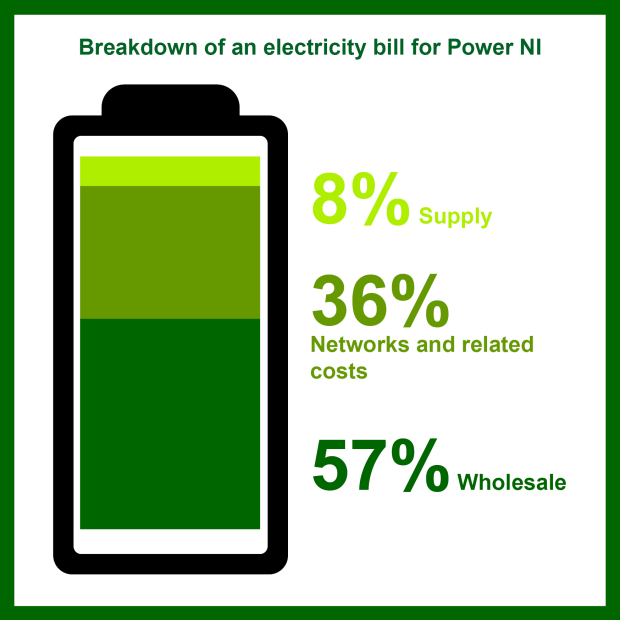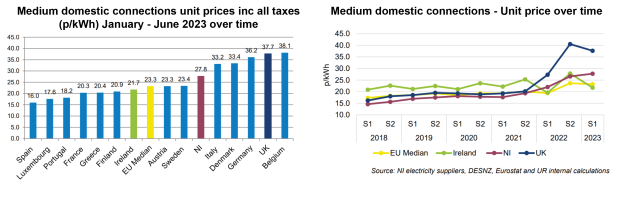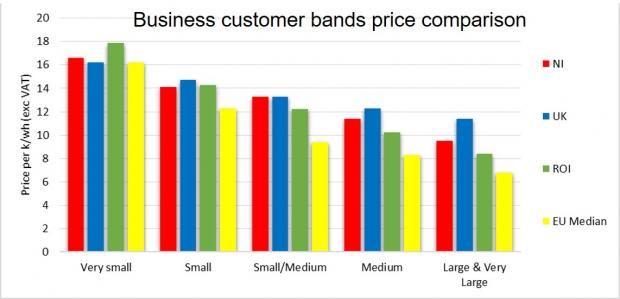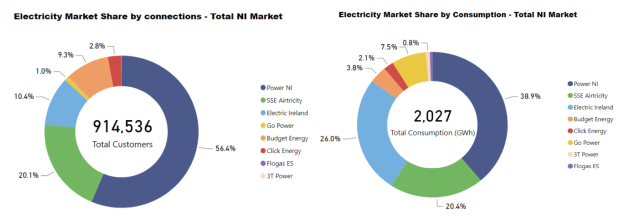What costs make up my energy bill?

Each of these 3 elements of the electricity system must be paid for by customers and make up the main parts of your electricity bill.
These costs can increase or decrease as a result of a number of factors including the level of demand for electricity, the types of generation available and the cost of fuel.
Prices and domestic customers
For homes across Northern Ireland, the average unit price of electricity is amongst the cheapest in Europe as the graphs below illustrate. It is also significantly below GB and RoI.
This has been the position in NI since 2016. For the last four years, the average unit price of electricity in NI has been, and continues to be, below the UK, RoI and GB median.
We report on these key statistics regularly through our Quarterly Transparency Reports. You can find more detail on market prices and key facts about both the electricity and gas markets for homes across Northern Ireland by reading more in the market information section.

Prices and Business Customers

The table opposite shows the average unit price for business customers in NI by size, compared with the rest of the UK, RoI and EU median.
Almost 68% of business customers in NI fall within the very small size category. This means the vast majority of business customers in NI benefit from very competitive electricity rates compared to the rest of the UK and RoI. This may not be the case for the large and very large businesses although they make up less than 0.02% of all NI businesses. The larger businesses do however use more electricity so their overall consumption is much greater than the larger number of smaller businesses. You can find more detail on prices and key facts about the electricity and gas markets for businesses across Northern Ireland by reading more in our market information section.

What the Regulator does across the 3 cost areas – wholesale, network, supply
As explained above, your bill is made up of the costs to deliver the three key elements of the electricity system – wholesale, network and supply. Our role is to ensure that the prices you pay reflect the real cost of delivering each of these elements. We do this by using a number of effective regulatory tools including price controls, tariff setting, scrutiny and detailed analysis.
WholesaleThe wholesale market operates across the island of Ireland and is comparable to the GB generation market and those that operate across Europe. We work through the all island Single Electricity Market Committee (SEMC) to ensure the market in which electricity is generated and traded is as efficient and effective as possible. Introduced in October 2018, our new market design saved consumers over £200m in the capacity remuneration mechanism (CRM) alone in its first year of operation – the CRM process is used to ensure there is always enough electricity available to meet the needs of all consumers. This new market is also helping to ensure consumers get the direct cost benefits from the increased levels of renewable generation available on the system. This market operates on an all-island basis to help ensure Northern Ireland consumers benefit from access to a larger, more interconnected market. We monitor how the market is operating and report quarterly on its performance. You can view these detailed reports in the SEM Committee website. |
NetworkThe transmission and distribution network companies (NIEN and SONI) are responsible for transporting the electricity to businesses and homes. We control the amount of money these monopoly companies are allowed to spend through a price control process. We drive down costs by assessing their business plans and allowing sufficient and necessary investment in the market at the lowest cost. The total network costs do not vary by large amounts year on year, however if consumption levels fall, the network charge per unit of energy consumed will rise. This is because the cost of the network still has to paid for but over a smaller number of consumers. We are also working to deliver key projects such as the North-South interconnector which will help to bring down costs for all customers. It is estimated that the absence of the NS interconnector is currently costing consumers over £20m per annum. Network costs also include a number of energy costs that arise because of government policy – taxes and green energy charges. |
SupplyAlthough we have competition in the supply market in NI, we are a small region and competition is not advanced or sufficient enough to properly protect consumers. We therefore continue to regulate the largest electricity supplier in NI, Power NI, so customers can be assured their prices directly reflect the cost of producing and supplying their electricity. We monitor prices continually and are able to act quickly to reflect any savings in consumers bills. Although we do not price regulate other competing suppliers, they are under pressure to keep their costs, and hence their prices, down to win new customers and keep their existing ones. Through our price control for Power NI, we also control the amount of profit the company is able to make. If the company makes more profit in a given period than our price control allows, we ensure this money is given back to customers through their tariff during the next period. For further information on your energy choices, please see our getting the best price section. |